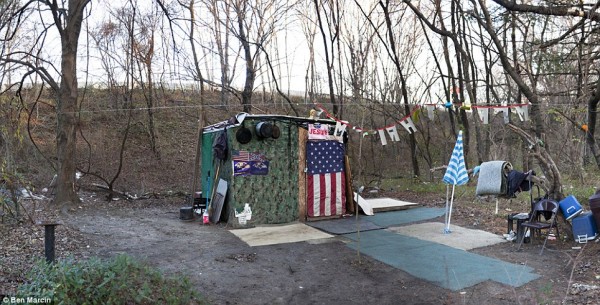Baltimore’s people of the woods: Inside the hidden homeless camps made of milk crates, wooden doors and tarps on the outskirts of town.
A sheet of plastic laid over a clothesline. A mini-fortress of milk crates stacked under a tree. A thin mattress on a flimsy crate lying in a dark tunnel. On the edge of Baltimore’s woodlands, dozens of the city’s transients live in makeshift homes which they consider safer than homeless shelters. Photographer Ben Marcin has captured some of the shanties in his thought-provoking photo essay, ‘The Camps’, documenting the struggle, loneliness and ingenuity of Maryland’s people of the woods.
The Camps: Snapper Ben Marcin has uncovered the illusive, hidden dwellings of Baltimore’s homeless in his moving photographic series.
Similar to his Last House Standing series which captured lonely rowhouses around the Mid-Atlantic, Marcin shot the shanties around Baltimore without their inhabitants to add to the ‘mystery’.
Marcin said he first stumbled upon the homeless dwellings as he hiked through the woods bordering the city during hunting season.
When he saw a ‘mini-fortress’ made of milk crates just yards from a major thoroughfare, Marcin began searching for other transients ‘living off the grid’.
Most were based near railroad tracks, Walmarts, gas stations, and liquor stores.
‘I have always been interested in the unique places people live in, particularly where there exists an element of defiance or desperation, or both. In these situations, a house can often reflect the dilemma of its owner. In the case of the hobo camps, this reflection is quite pronounced for obvious reasons,’ he told The Atlantic Cities.
‘A sheet of plastic laid out over a clothesline may be the last stand for somebody who has either been rejected by society or who has refused to conform to whatever rules are being imposed on them.
‘Several camp people I talked to said they wouldn’t relocate into one of the City’s shelters because they were afraid of being assaulted or having belongings stolen.’
Marcin said about year after finishing the project, he returned to the woods to find all the camps were gone. One had burned to the ground, some had been bulldozed, while others moved to different locations.
‘My guess is that these, too, will not be around for long,’ he said.
Other Ben Marcin photographic collections can be viewed at his website benmarcinphotos.com or at C. Grimaldis Gallery in Baltimore, Maryland.
[nggallery id=”124″]

